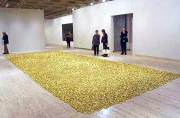 |
Arlyne Moi
Towards a Justifiable Conception of ‘the Autonomous Artwork’
in Today’s Artworld
|
Thesis for a Hovedfag * in Philosophy at the University
of Bergen - Spring 2005.
* A "Hovedfag" is the old Master's
Degree at the universities in Norway,
the degree, and especially the paper/thesis is larger and more
independently written than for the present Master's Degree.
ACKNOWLEDGEMENTS
I would like to thank Lars Fr. H. Svendsen, Deirdre C. P. Smith, Kjetil
Skjerve, Thomas E. Payne, Vibeke Tellmann, Anders Reiersgaard and Christer
Swartz for reading portions of earlier drafts of this paper, and for
commenting on aspects of them. Also thanks to Hanne Beate Ueland of
Astrup Fearnley Museum of Modern Art, Oslo, for making available to
me many of the artworks discussed here.
In the time of writing, the work of
writing can never be concluded: the work remains unfinished and unfinishable,
as if beginning and beginning again in an eternal return of a present
that endures without a future and from which there is no exit.
(Maurice Blanchot, The Step Not Beyond)
Stamp out, and eradicate, superfluous
redundancy. (Thomas E. Payne)
TABLE OF CONTENTS
CHAPTER 1. INTRODUCTION
The autonomous artwork is a controversial issue;
The autonomous artwork is a confused issue;
Problemstilling and thesis statement; overview of chapters
CHAPTER 2. BACKGROUND AND ROOTS OF
‘THE AUTONOMOUS ARTWORK’
Nomos; Auto:
The self Autonomous combined with artwork-self
CHAPTER 3. KANT AND THE BUILDING
BLOCKS OF AUTONOMY
The four moments, the artist genius and the aesthetic idea;
What are the building-blocks of autonomy?
CHAPTER 4. TOWARDS A CONCEPTUAL CLARIFICATION
OF ‘THE AUTONOMOUS ARTWORK’
SECTION I: CONCEPTIONS OF THE ‘AUTONOMOUS ARTWORK’ WITH WEAK ONTOLOGICAL
COMMITMENTS
A. The work’s autonomous status as being related to the artist
B. ‘The autonomous artwork’ understood in terms of its reception
i. Attitude theories: The aesthetic attitude and the judgment
of taste
ii. The artwork is free of moral liability because all moral
obligation lies with the judge
iii. Reception of artworks as non-conceptual, as feeling only
iv. ‘Autonomous artwork’ understood in terms of reception
being under- determined by the symbolic form of language
C. The artwork’s autonomy understood in relation to the artworld’s
separation from the rest of society, or the work’s separation from
the artworld
SECTION II. ONTOLOGICAL APPROACHES TO THE WORK’S AUTONOMY
A. Aesthetic Realism
i. The Aesthetic object;
ii. Significant form;
iii. Pure intentionality
B. Views focusing on the aesthetically perceptible artwork
iv. Formalism and Aestheticism: value is independent of
meaning, reference and utility;
v. A delimited world of forms and symbols, self-sufficient for
its correct interpretation;
vi. Essentialism’s autonomy;
vii. No universal definition;
viii. No definition at all;
ix. Intuitive expression;
x. Purposiveness without determinate purpose;
xi. The double character
SUMMARY
A synthesis of provisional moments of autonomy for the artwork
CHAPTER 5. HEIDEGGER, BLANCHOT AND
DERRIDA on the AUTONOMOUS ARTWORK
A. Heidegger’s artwork: earth and world striving
The workly character of the artwork;
The work subsists in itself;
The earth
withdraws, occludes itself;
The world is unknowable
B. Blanchot’s double character
The dead and the autonomous artwork;
‘The autonomous artwork’ as negator of artist, receiver and meaning;
What is ‘the autonomous artwork’ for?;
The relationship between the two slopes
DISCUSSION PART 1: OF HEIDEGGER AND BLANCHOT’S ‘AUTONOMOUS ARTWORK’
Ambiguity with the status of the earth and world, and the dead
and autonomous slopes;
Is the autonomous artwork prior, and thus the condition for signification
and value?
A problem with Blanchot’s fragmented consciousness vis a vis
the zombifying artwork
Is ontological priority at all a relevant issue for contemporary
artworks?
Ontological solitude
The artwork’s fragmentary nature
C. Derrida: The undecidable artwork
Derrida’s deconstructive practice;
‘The autonomous artwork’ understood as having undecidable form;
‘The autonomous artwork’ understood as non-restorable to a corresponding
truth;
‘The autonomous artwork’ understood as non-restorable to a purpose
DISCUSSION PART 2: DERRIDA’S NARRATIVE OF THE AUTONOMOUS ARTWORK,
WITH COMPARISON TO KANT, HEIDEGGER AND BLANCHOT
1. The work, the artist and the receiver in light of undecidability
Undecidability makes the subject fall apart
2. The undecidable artwork’s separation from truth-as-correspondence
Derrida’s scepticism;
Demonstrating non-restitution: A secret and contradictory trust in
truth-as-correspondence?
3. The undecidable purpose
Judgment of purpose: An art-religion?
The undecidable artwork and moral concerns: Is the artwork morally
obligated?
4. How successful is Derrida’s failure?
The usefulness of the undecidable artwork
SUMMARY: ‘The HBD autonomous artwork’
CHAPTER 6. A THIRD HYBRID
The PH viewed through the tense of the HBD and
vice versa
The artist’s authenticity of expression in light of undecidability
Law-likeness without a law: agency and product;
‘Authenticity’ as taking responsibility for one’s artistic expression
The receiver’s responsibility in light of undecidability
A THIRD HYBRID
CHAPTER 7. CONCLUSION
BIBLIOGRAPHY
|